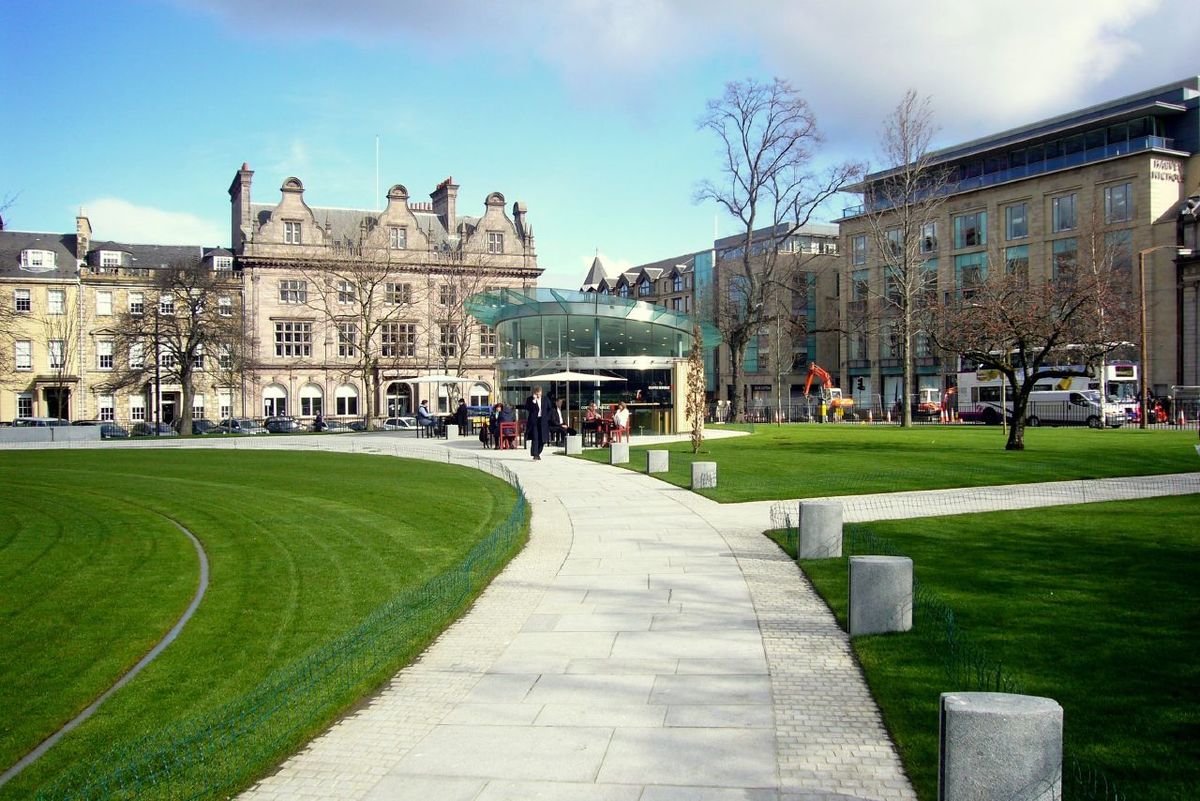
The Assembly Rooms
Photograph: Sylvia Stanley, Wikimedia Commons (BY-SA)
The Assembly Rooms
The new Assembly Rooms of Edinburgh were designed by the architect John Henderson (1804 – 1862) who won a competition in December of 1781 organized by Edinburgh Town Council. The winning design was classical and entirely in keeping with Edinburgh New Town. The Assembly Rooms opened on 11 January 1787 for the Caledonian Hunt Ball, tragically shortly after Henderson died in 1786. Thereafter they were used for major social events including the first Edinburgh Music Festival in 1815, housed in the Ballroom and the Peers Ball on the occasion of a visit by King George IV to Edinburgh in 1822 (see section 2). In 1827 the Edinburgh Theatrical Fund Association used the Assembly Rooms for their annual dinner. Famously, at this event, in front of three hundred fellow guests, judge Lord Meadowbank revealed that Sir Walter Scott was the "The Great Unknown" author of the Waverley Novels.
Cross the street to number 45.
Across the road at 45 George Street, this classical building was home to the Blackwood's Edinburgh Magazine, founded by the publisher William Blackwood and printed between 1817 and 1980. Originally called the Edinburgh Monthly Magazine, it was relaunched under the editorship of Thomas Pringle as Blackwood's Edinburgh Magazine. The journal was popularly referred to by the shorter name, Maga. Initially notorious for satirizing the Edinburgh Whigs, it also published short stories, poetry and serialized novels, including among its more famous contributors Sir Walter Scott, James Hogg and Thomas de Quincey during the Enlightenment and George Eliot, Joseph Conrad, John Buchan and Samuel Taylor Coleridge at later dates. The majority of issues of the magazine can be accessed freely online.
James Hogg (1770–1835) in particular played a key role in the launch and promotion of Maga, in which he also published more than one hundred works. Nonetheless he was a controversial figure, disdained by many writers of his age such as William Wordsworth who wrote of him:
"He was undoubtedly a man of original genius, but of coarse manners and low and offensive opinions." As a result, he was for a time excluded from Maga especially when writers such Thomas de Quincey became contributors. The true value of Hogg’s literary output was not fully recognized until André Gide obtained his The Private Memoirs and Confessions of a Justified Sinner and noted that "It is long since I can remember being so taken hold of, so voluptuously tormented by any book." This lead to the book’s republication with an introduction by Gide. It was indeed an extraordinary contribution to the enlightenment with its singeing description of Antinomian thinking and its calculated and disturbing representation of evil.
The first volume of the magazine published in April 1817 contained an article about the Scottish Gypsies, quoting considerably from James Hogg and prefaced by this piece of his poetry, which evokes a more complimentary and truer view of gypsies than many of his contemporaries shared:
“Hast thou not noted on the bye-way side,
Where aged saughs lean o’er the lazy tide,
A vagrant crew, far straggled through the glade,
With trifles busied, or in slumber laid;
Their children lolling round them on the grass
Or pestering with their sports the patient ass,
The wrinkled beldame there you may espy,
- And ripe young maiden with the glossy eye-
Men in their prime, - and striplings dark and dun, -
Scathed by the storm and freckled with the sun,
Their swarthy hue and mantle’s flowing fold,
Bespeak the remnant of a race of old:
Strange are their annals! – list, and mark them well –
For thou hast much to hear and I to tell.”

The Blackwood's Edinburgh Magazine, cover page, Vol. XXV, January – June 1829. William Blackwood, Edinburgh and T. Cadell, Strand, London with a portrait of 16th century Scottish historian George Buchanan on the cover

William Blackwood
Engraving, public domain


